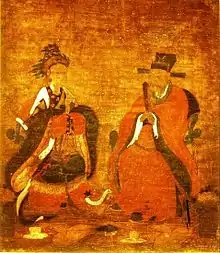Queen Noguk
Queen Noguk of the Borjigin clan (? – 1365), also known by her posthumous name Queen Indeok, was an ethnic Mongol princess and queen of Goryeo by marriage to King Gongmin. Her Mongolian name was Budashiri (Mongolian: Будшир; Middle Mongolian: ᠪᠦᠳᠬᠠᠱᠢᠷᠢ; Chinese: 寶塔實里 or 寶塔失里).
| Queen Indeok 인덕왕후 | |||||
|---|---|---|---|---|---|
 | |||||
| Queen consort of Goryeo | |||||
| Tenure | 1351 – 1365 | ||||
| Predecessor | Princess Deoknyeong | ||||
| Successor | Royal Consort Sun-bi | ||||
| Born | ? Yuan dynasty | ||||
| Died | 8 March 1365 Kingdom of Goryeo | ||||
| Burial | |||||
| Spouse | King Gongmin of Goryeo | ||||
| |||||
| House | Borjigin | ||||
| Father | Bayir Temür | ||||
| Religion | Buddhism | ||||
| Queen Noguk | |
| Hangul | |
|---|---|
| Hanja | |
| Revised Romanization | Noguk Daejang Gongju |
| McCune–Reischauer | Nokuk Taechang Kongchu |
| Posthumous name | |
| Hangul | |
| Hanja | |
| Revised Romanization | Indeok Wanghu |
| McCune–Reischauer | Intŏk Wanghu |
| Korean Personal Name | |
| Hangul | |
| Hanja | |
| Revised Romanization | Wang Gajin |
| McCune–Reischauer | Wang Kachin |
Life
Queen Noguk was born Budashiri, a member of the Yuan dynasty's ruling Borjigin clan and a great-great-great granddaughter of Kublai Khan. Though her birth year is unknown, she is recorded as having married the reformist monarch Gongmin of Goryeo in the Yuan capital of Khanbaliq in 1349, after which she went to live in Goryeo.
Queen Noguk's marriage followed a practice established by Kublai Khan, where female members of the Yuan imperial clan were married to Goryeo princes in order to maintain Yuan hegemony on the Korean peninsula.[1] By contrast with earlier marriages between the Yuan and Goryeo dynasties, however, Budashiri's marriage to Gongmin was described as happy.[1]
Despite the close relationship between King Gongmin and her, they were childless. Queen Noguk became pregnant fifteen years after marriage, but died in 1365 from complications related to the childbirth.[2]
After her death, King Gongmin became indifferent to politics and entrusted great tasks to a Buddhist monk, Pyeonjo, who was executed in 1371. King Gongmin was killed in his sleep by Hong Ryun (홍륜), Choe Man-saeng (최만생), and others in 1374.
Legacy
.jpg.webp)
King Gongmin began the construction of a tomb near Kaesong after Queen Noguk's death. The queen was interred under the mound Jongrung, and her husband was later buried under an accompanying mound known as Hyonrung.[3]
In 1367, she posthumously received the title "princess supreme" (daejang gonju, 大長公主) – typically accorded to aunts of emperors (even though she was not).[4][N 1]
According to the Veritable Records of the Joseon Dynasty, the tenth king Yeonsan believed that Queen Noguk had looked similar to his mother, the deposed Queen Yun, so he collected Queen Noguk's portraits at government offices.[5]
Family
- Father: Bayir Temür
- Grandfather: Amüge (making Princess Joguk – who also moved to Korea – her aunt)
- Great-grandfather: Darmabala
- Great-great-grandfather: Borjigin Zhenjin
- Great-grandfather: Darmabala
- Grandfather: Amüge (making Princess Joguk – who also moved to Korea – her aunt)
- Husband: King Gongmin of Goryeo (23 May 1330 – 27 October 1374) (고려 공민왕)
In popular culture
- Portrayed by Sunwoo Eun-sook in the 1983 KBS TV series Foundation of the Kingdom.
- Portrayed by Seo Ji-hye in the 2005-2006 MBC TV series Shin Don.
- Portrayed by Song Ji-hyo in the 2008 film A Frozen Flower.
- Portrayed by Park Se-young in the 2012 SBS TV series Faith.
- Portrayed by Bae Min-Hee in the 2012-2013 SBS TV series The Great Seer.
Ancestors
| Ancestors of Queen Noguk | |||||||||||||||||||||||||||||||||||||||||||||||||||||||||||||||||||||||||||||||||||||||||||||||||||||||||||||||||||||||||||||||||||||||||||||||||||||||||||||||||||||||||||||||||||||||||||||||||||||||||||||||||||||||||||||||||||||||||||||||||||||||||||||||||||||||||||||||||||||||||||||||||||||||||||||||||||||||||||
|---|---|---|---|---|---|---|---|---|---|---|---|---|---|---|---|---|---|---|---|---|---|---|---|---|---|---|---|---|---|---|---|---|---|---|---|---|---|---|---|---|---|---|---|---|---|---|---|---|---|---|---|---|---|---|---|---|---|---|---|---|---|---|---|---|---|---|---|---|---|---|---|---|---|---|---|---|---|---|---|---|---|---|---|---|---|---|---|---|---|---|---|---|---|---|---|---|---|---|---|---|---|---|---|---|---|---|---|---|---|---|---|---|---|---|---|---|---|---|---|---|---|---|---|---|---|---|---|---|---|---|---|---|---|---|---|---|---|---|---|---|---|---|---|---|---|---|---|---|---|---|---|---|---|---|---|---|---|---|---|---|---|---|---|---|---|---|---|---|---|---|---|---|---|---|---|---|---|---|---|---|---|---|---|---|---|---|---|---|---|---|---|---|---|---|---|---|---|---|---|---|---|---|---|---|---|---|---|---|---|---|---|---|---|---|---|---|---|---|---|---|---|---|---|---|---|---|---|---|---|---|---|---|---|---|---|---|---|---|---|---|---|---|---|---|---|---|---|---|---|---|---|---|---|---|---|---|---|---|---|---|---|---|---|---|---|---|---|---|---|---|---|---|---|---|---|---|---|---|---|---|---|---|---|---|---|---|---|---|---|---|---|---|---|---|---|---|---|---|---|---|---|---|---|---|---|---|---|---|---|---|---|---|---|---|---|
| |||||||||||||||||||||||||||||||||||||||||||||||||||||||||||||||||||||||||||||||||||||||||||||||||||||||||||||||||||||||||||||||||||||||||||||||||||||||||||||||||||||||||||||||||||||||||||||||||||||||||||||||||||||||||||||||||||||||||||||||||||||||||||||||||||||||||||||||||||||||||||||||||||||||||||||||||||||||||||
See also
References
- Her father's only known brother, Alu (阿魯), did not father any emperors, so she was not aunt to an emperor. There was precedence, however, to the title of "princess supreme" being bestowed to women who were not an emperor's aunt, for instance, Sengge Ragi, an emperor's sister.
- Hu, Chien-Ju (2017). "A Preliminary Survey on the Late Period of Royal Marriage Between Yuan-Goryeo Dynasties". The History Education Review (in Korean). 24: 193–214.
- Weatherford, Jack (2010). The secret history of the Mongol queens: how the daughters of Genghis Khan rescued his empire (1st ed.). New York: Crown Publishers. p. 127. ISBN 9780307407153. OCLC 354817523.
- "노국대장공주" [Princess Noguk]. Encyclopedia of Korean Culture (in Korean). Retrieved 11 February 2020.
- Farmer, Edward L. (1995). Zhu Yuanzhang and Early Ming Legislation. Brill. p. 140. ISBN 90-04-10391-0.
The emperor's agnatic aunt shall be called Princess Supreme [dazhang gongzhu]. The emperor's sisters shall be called Grand Princesses [zhang gongzhu].
- Veritable Records of the Joseon Dynasty: Yeonsan. 21. Year 3, Month 2, Day 15.
External links
| Preceded by Princess Deoknyeong |
Queen consort of Korea 1351 – 1365 |
Succeeded by Royal Consort Sun-bi |
